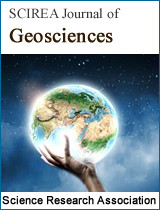Removal, Recovery, and Recycles of Gold (III) from Aqueous Gold (III) Solution Using Immobilized Pseudomonas saccharophila Cells by Biomineralization and Thiourea Oxidation
DOI: 10.54647/geosciences17102 123 Downloads 14038 Views
Author(s)
Abstract
Recently, some researchers have investigated the recovery of gold using microbial cells, such as bacteria, fungi, yeasts, and algae. However, there is little information on which kind of microorganisms has a high gold adsorbing ability. We have reported various species and strains of bacteria, actinomycetes, fungi, and yeasts were screened for their ability to adsorb gold from a solution containing hydrogen tetrachloroaurate (III). Hydrogen tetrachloroaurate (III) is used for medical and ceramic materials. The effect of pH, external gold concentration, cell amounts on gold biosorption, and the time course of gold biosorption by Pseudomonas maltophilia cells, which adsorbed large amounts of gold from a solution containing hydrogen tetrachloroaurate (III), were reported in detail. In this chapter, in order to approve the amount of gold recovery much higher, the removal of gold (III) by biosorption and biominaralization from aqueous systems using microbial cells, gold (III) removal by those using microbial cells was investigated.Additionally,the oxidative recovery of gold after reduced gold(0) by the oxidation using aqueous thiourea solution, and recycles of gold reduction-oxidation cycles.
Keywords
gold (III) biosorption, gold (0) biomineralization, microorganism, Peudomonas saccharophila, thiourea, recycles
Cite this paper
Takehiko Tsuruta, Yuki Odajima, Kato Marina, Ichiro Maeda,
Removal, Recovery, and Recycles of Gold (III) from Aqueous Gold (III) Solution Using Immobilized Pseudomonas saccharophila Cells by Biomineralization and Thiourea Oxidation
, SCIREA Journal of Geosciences.
Volume 5, Issue 1, February 2021 | PP. 1-16.
10.54647/geosciences17102
References
| [ 1 ] | Suhr, M., Raff and J., Pollmann, K, “Au-Interaction of Slp1 Polymers and Monolayer from Lysinibacillus sphaericus JG-B53-QCM-D, ICP-MS and AFM as Tools for Biomolecule-metal Studies,” J. Vis. Exp., 107. e53572. 2016. |
| [ 2 ] | Paez-Velez, C., Rivas, R.E., and Dussan, J, “Enhanced Gold Biosorption of Lysinibacillus sphaericus CBAM5 by Encapsulation of Bacteria in an Alginate Matrix,” Metals, 9. 818-827. 2019. |
| [ 3 ] | Gomes, N.C.M., Camargos, E.R.S., Dias, J.C.T., and Linardi, V.R, “Gold and Silver Accumulation by Aspergillus niger from Cyanide-containing Solution Obtained from the Gold Mining Industry,” World J. Microbiol. Biotechnol., 14. 149. 1998. |
| [ 4 ] | Matsumoto, M. and Nishimura, Y, “Recovery by Aspergillus oryzae of Gold from Waste Water from Gold Plating,” Nippon Nougeikagakukaishi, 66. 1765-1770. 1992 (in Japanese). |
| [ 5 ] | Pethkar, A.V. and Paknikar, K.M, “Recovery of Gold from Solutions Using Cladsporium cladosporioides Biomass Beads,” J. Biotechnol., 63. 121–136. 1998. |
| [ 6 ] | Karamuchka, V. and Gadd, G.M, “Interaction of Saccharomyces cerevisiae with Gold: Toxicity and Accumulation,” BioMetals, 12. 289–294. 1999. |
| [ 7 ] | Hosea, M., Greene, B., McPherson, R., Henzl, M., Alexander, M.D., and Darnall, D.W, “Accumulation of Elemental Gold on the Aalga Chlorella vulgaris,” Inorg. Chim. Acta, 123. 161–165. 1986. |
| [ 8 ] | Kuyucak, N., and Volesky, B, “Accumulation of Gold by Algal Biosorbent,” Biorecovery, 1. 189–204. 1989. |
| [ 9 ] | Tsuruta, T, “Biosorption and Recycling of Gold Using Various Microorganisms,” J. Gen. Appl. Microbiol., 50. 221–228. 2004. |
| [ 10 ] | Tsuruta, T, “Removal and Recovery of Lithium Using Various Microorganisms,” J. Biosci. Bioeng., 100. 562-566. 2005. |
| [ 11 ] | Tsuruta, T., Umenai, D., Hatano, T., Hirajima, T., and Sasaki, K, “Screening Micro-organisms for Cadmium Absorption from Aqueous Solution and Cadmium Absorption Properties of Arthrobacter nicotianae,” Biosci. Biotechnol. Biochem., 78. 1791-1796. 2014. |
| [ 12 ] | Tsuruta, T, “Removal and Recovery of Uranyl Ion Using Various Microorganisms,” J. Biosci. Bioeng., 94. 23-28. 2002. |
| [ 13 ] | Tsuruta, T,. “Accumulation of Thorium Ion Using Various Microorganisms,” J. Gen. Appl. Microbiol., 49. 215-218. 2003. |
| [ 14 ] | Tsuruta, T, “Accumulation of Rare Earth Elements in Various Microorganisms,” J. Rare Earths, 25. 526-532. 2007. |
| [ 15 ] | Conn, E.E., Stumpf, P.K., Bruening, G., and Doi, R. H, Outlines of Biochemistry, 5th ed., Wiley, New York, U. S. A., 292–293. 1987. |
| [ 16 ] | Fischer, W., Ishizuka, I., Landgraf, H.R., and Herrmann, J, “Glycerophosphoryl Diglucosyl Diglyceride, A New Phosphoglycolipid from Streptococcus, Biochim. Biophys. Acta, 296. 527–545. 1973a. |
| [ 17 ] | Fischer, W., Landgraf, H.R., and Herrmann, J, “Phosphatidyldiglucosyl Diglyceride from Streptococci and Its Relationship to Other Polar Lipids,” Biochim. Biophys. Acta, 306. 353–367. 1973b. |
| [ 18 ] | Paul, R.J. and Schneckenburger, H, “Oxygen Concentration and the Oxidation-reduction State of Yeast: Determination of Free/Bound NADH and Flavins by Time-Resolved Spectroscopy,” Sci. Nat., 83. 32-35. 1996. |
| [ 19 ] | Maeda, I. and Tsuruta, T, “Microbial Gold Biosorption and Biomineralization from Aqueous HAuCl4 Solution,” Minerals, 10. 285-293. 2020. |
| [ 20 ] | Doremus, R. H, “Optical Properties of Small Gold Particles,” J. Chem. Phys., 40. 2389-2396. 1964.. |

